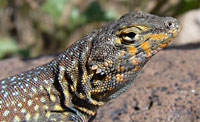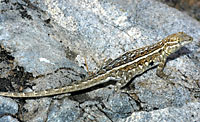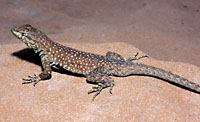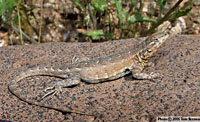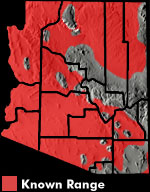Online Field Guide to The Reptiles and Amphibians of Arizona


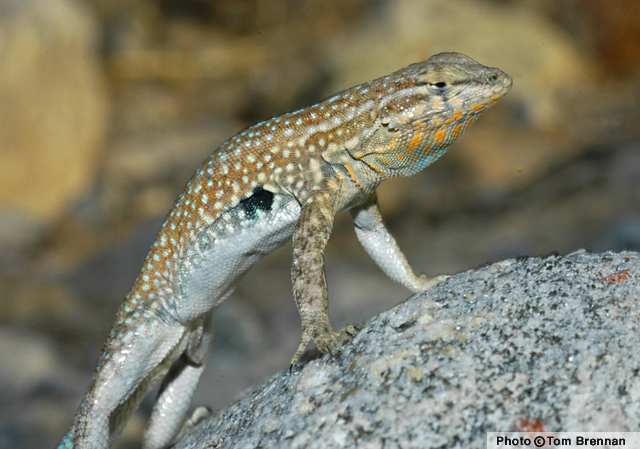
Male territorial display. Maricopa County, AZ
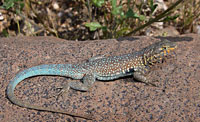 Male. Maricopa Co., AZ |
||
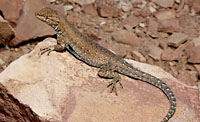 U. s. uniformis Fem. Coconino Co. |
| COMMON SIDE-BLOTCHED LIZARD Uta stansburiana |
|
|
DESCRIPTION: A small (up to 64 mm or 2.5″ from snout to vent), orange-tan to gray-brown lizard. A dark blue-gray to black blotch marks each lower side of the body just behind the forelimb. Markings are variable and can include brown chevron-shaped blotches, light dorsolateral stripes, no pattern, and speckles. The lips and sides of the throat are often marked with alternating orange and gray to blue-gray stripes. The remainder of the underside is plain pale gray. Males often have bright turquoise blue speckling on the tail, back, and upper surfaces of the hind limbs. Females lack blue speckling and usually have light dorsolateral stripes. The scales on the body are small and mildly keeled. The scales on the tail are larger and more strongly keeled. The belly scales are smooth and flat and the scales on the top of the head are large and smooth. Its single side blotch distinguishes this lizard from our other small lizards. External ear openings further distinguish it from the similar looking Common Lesser Earless Lizard and Elegant Earless Lizard. DISTRIBUTION: It is distributed across most of Arizona and is absent only from our high mountains and our central Mogollon Rim countr. It occurs at elevations ranging from near sea level along the Colorado River to about 6,500’. HABITAT: The Common Side-blotched Lizard inhabits all four of our state’s desertscrub communities, Semidesert Grassland, Interior Chaparral, and Great Basin Grassland. It can be found in a wide variety of terrain types ranging from sand dunes to rocky hillsides. It is usually encountered in relatively open, sunny areas. BEHAVIOR: This diurnal lizard can be active at any time of the year but winter activity is usually restricted to sunny, warm days. During the summer it is most active mid morning and late afternoon. It is primarily a ground-dweller that is commonly seen around the bases of small shrubs and on the banks of rocky washes. It regularly climbs onto low rocks and fallen wood to bask. Polygynous, but often seen in male-female pairs. REPRODUCTION: Multiple clutches of eggs are laid in spring and summer. Clutch size ranges from 2 to 5 eggs. Hatchlings begin to emerge in June. By Thomas C. Brennan
Brennan, T. C., and A. T. Holycross. 2005. A Field Guide to Amphibians and Reptiles of Maricopa County. Arizona Game and Fish Department. Phoenix, AZ Degenhardt, W. G., Painter, C. W., and Price, A. H.. 1996. Amphibians and Reptiles of New Mexico. University of New Mexico Press. Albuquerque. Stebbins, R.C. 2003. A Field Guide to Western Reptiles and Amphibians, Third Edition. Houghton Mifflin Company, Boston, MA. |
|
Visit Partners in Amphibian and Reptile Conservation:


HOME
Copyright © 2023, Arizona Game and Fish Department. All rights reserved.
If you make use of the textual contents of this site in reports, publications, etc. please cite and credit the author(s) and photographer(s). All photos on this website are copyrighted. However, those found in the species account section may be used for any noncommercial scientific, educational, or conservation purposes provided that photographs are not altered and continue to bear the copyright symbol and name of the photographer. Please contact the photographer regarding commercial use of copyrighted photographs.










